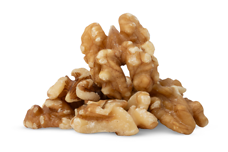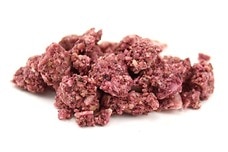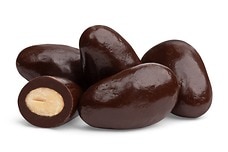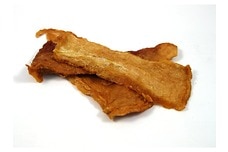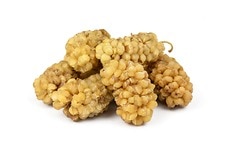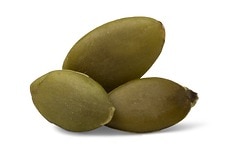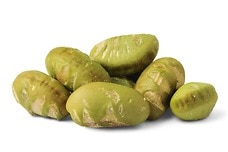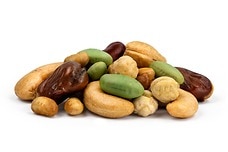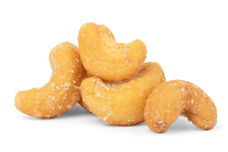Vegetarian Diet
More than 22 million Americans follow a vegetarian diet (Vegetarian Times, n.d.), with millions more frequently adding vegetarian meals to their meal plans. Following a vegetarian or vegan diet is associated with numerous health benefits, although it is important to ensure that meals are nutritionally complete.
Central Concepts of the Vegetarian Diet
The basic concept behind the vegetarian diet is to avoid eating meat. This typically includes red meat, pork, poultry, or fish. However, there are several varieties of vegetarian diet, each differing slightly in the foods that are allowed or avoided:
- Pescatarian: excludes consumption of meat, poultry, and dairy. Fish are permitted. Some pescatarians eat eggs, while others do not.
- Lacto-vegetarian: excludes consumption of all meat, poultry, and fish. Eggs are also excluded, but dairy products (e.g., cheese, milk, yogurt) are permitted.
- Ovo-vegetarian: excludes consumption of meat, poultry, fish, and dairy products. Eggs are permitted.
- Lacto-ovo vegetarian: excludes consumption of meat, poultry, fish, and dairy products. Both eggs and dairy products are permitted.
- Pollotarian: excludes consumption of red meat, pork, and fish. Poultry products are permitted.
- Vegan diet: excludes consumption of any animal products, including meat, poultry, fish, eggs, and dairy products; the strictest of vegans also avoid animal by-products (e.g. honey).
Constructing a Healthy, Nutritionally Complete Vegetarian Diet
A healthy vegetarian diet requires a balance of carbohydrates, proteins, and fats. The best vegetarian diet is one that incorporates fruits, vegetables, whole grains, plant-based proteins, and healthy oils. For example, you should aim to eat at least 2.5 cups of vegetables and 2 cups of fruit per day (Mayo Clinic, 2016).
Try to eat fruits and vegetables from across the color spectrum. This increases the variety of nutrients you receive, helping your meals become more nutritionally complete. Each day, try to incorporate 6 ounces of grains into your diet, with at least half coming from whole grain sources such as buckwheat, whole-wheat bread, quinoa, or farro. Finally, focus on healthier fats from ingredients list: olive oil, safflower oil, or other healthy nut or vegetable oils.
Many people interested in becoming a vegetarian wonder about their ability to get enough protein. Getting appropriate amounts of protein is a relevant concern for vegetarians, but there are numerous non-meat sources of protein that can ensure that you do not become protein deficient. Aim for 3 to 4 ounces of protein per day (Mayo Clinic, 2016). Some ideas for adding protein to meals include:
- Tofu
- Tempeh
- Beans (e.g., chickpeas, kidney or black beans)
- Lentils
- Yogurt
- Cheese
- Milk
- Cottage cheese
- Nuts
- Seeds
- Eggs
- Whole grains
Research Evidence Supporting a Vegetarian Diet
Vegetarian diets have been well researched over the past few decades. In a 2012 meta-analysis of studies comprising nearly 125,000 participants, a vegetarian diet was associated with a 30% reduction in heart disease deaths, 16% fewer deaths from circulatory diseases, 12% lower mortality from cerebrovascular disease (e.g., strokes), and an 18% reduction in cancer deaths (Huang et al., 2012).
In addition to the beneficial effects of vegetarianism on health, reducing consumption of animal products may also be helpful to the environment by reducing carbon emissions (Fox, 2000). Switching to a vegetarian diet does require some planning and creative thinking to create healthy, balanced meals. Individuals interested in becoming a vegetarian may want to begin by adopting “Meatless Monday” one day per week before expanding their culinary repertoire to include full-time vegetarianism.
Health Concerns Associated with Becoming a Vegetarian
There are relatively few health concerns associated with becoming a vegetarian. However, vegetarians need to be careful to ensure they get the nutrients needed to stay healthy. For example, vitamin B12 is commonly found in animal products and may be less readily available in a vegetarian diet (Office of Dietary Supplements, 2016). Vegetarian sources of vitamin B12 include eggs, fortified breakfast cereals, milk, and yogurt.
Vegetarians must also be careful to ensure they get enough iron, zinc, calcium, vitamin D, and omega-3 fatty acids (Go Red for Women, n.d.). These nutrients are best obtained from whole food sources. For example, omega-3 fatty acids may be found in walnuts, ground flaxseed, canola oil, and soybeans (Mayo Clinic, 2016).
Not all vegetarian meals are inherently healthier than those that contain meat. Some meatless meals add large amounts of cheese, cream, or other foods high in saturated fat. Furthermore, eating foods such as french fries, chips or highly processed foods can be detrimental to health. Thus, it is best for vegetarians to focus on getting plenty of fresh fruits and vegetables, whole grains, nuts and seeds, and non-animal proteins in their diet.
Healthy Vegetarian Recipes
A vegetarian diet is healthy and ethical, but it can also be delicious. Discover some of the richest flavors for breakfast, lunch, dinner, and more with this selection of delectable vegetarian recipes- and find even more, including an abundance of delicious desserts on our vegan recipes page!
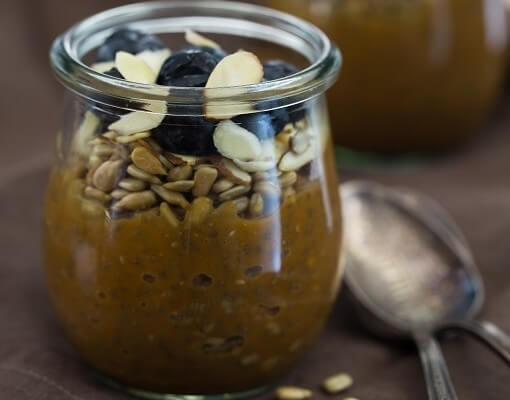
Pumpkin Chia Seed Pudding Recipe
This palatable pudding proffers a potent pumpkin flavor in a soft treat with a complimentary crunch. A brilliant breakfast, this scrumptious serving of seeds, nuts, berries, and more offers nearly 6 grams of protein, a full 4 grams of fiber, and more than 100% of the Daily Value for vitamin A!
Ingredients: Milk, pumpkin puree, chia seeds, maple syrup, pumpkin spice, sunflower seeds, sliced almonds, fresh blueberries.
Total Time: 10 minutes
| Yield: 4 servings
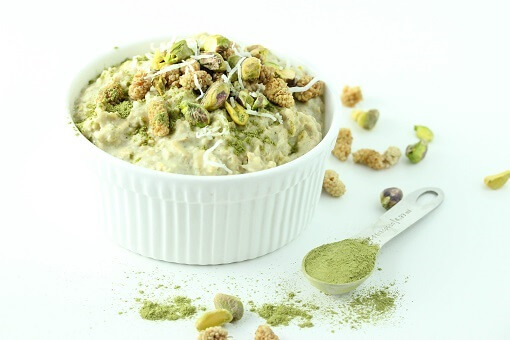
Moringa Oatmeal Recipe
Another idyllic option for breakfast, this moringa oatmeal makes for a tasty way to start your day that is just as nutritious as it is delicious. Each serving of the stuff contains nearly 13 grams of fiber, more than 12 grams of protein, 58% of the DV for calcium, 40% of the DV for iron, and 64% of the DV for vitamin C.
Ingredients: Gluten-free rolled oats, almond milk, agave or maple syrup, vanilla extract, moringa powder, pistachios, dried mulberries, unsweetened shredded coconut, chia seeds.
Total Time: 10 minutes
| Yield: 4 servings

Kale Quinoa Salad Recipe
This superb salad takes health to another level with a scrumptious blend of wholesome ingredients. Each bowl of this delectable dish offers a low calorie dish that is packed with potassium, fiber, protein, and all the other nutrients needed to keep you healthy- with a blend of flavors and textures that is sure to keep your tongue happy!
Ingredients: Quinoa, fresh baby kale, purple cabbage, carrots, fresh dill, boiled eggs, rice wine, extra virgin olive oil, black pepper.
Total Time: 25 minutes
| Yield: 8 servings
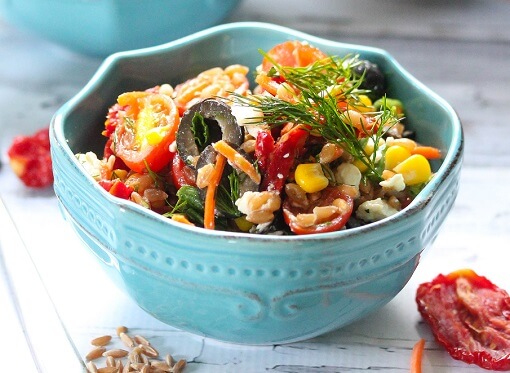
Farro Vegetable Salad Recipe
Toss your stale conception of salad to the wind because this veritably ambrosiac dish is redefining the dish with a blend of wholesome grains, cheeses, fruits, and herbs. The hearty mix also supplies an impressive 14.5 grams of fiber and 16 grams of protein in each serving, as well as more than 20% of the DV for vitamin A, vitamin C, potassium, calcium, and iron.
Ingredients: Organic farro, sun dried tomatoes, frozen corn (thawed), scallions, black olives, feta cheese, cherry tomatoes, shredded carrots, salt, fresh dill, fresh mint, extra virgin olive oil, balsamic vinegar.
Total Time: 1 hour
| Yield: 6 servings
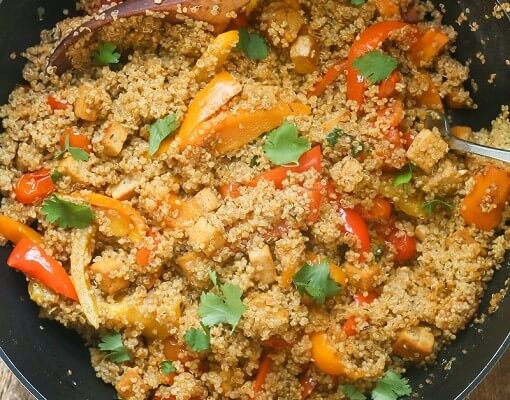
Veggie Quinoa Casserole Recipe {gluten-free, vegan}
A hearty dinner with a delicious savor, this wholesome blend of peppers, spices, quinoa, and tofu is ideal for calming a rumbling stomach. Each plate of this gluten-free dish doles out 6 grams of fiber and 17 grams of protein to keep you satisfied. The dish also keeps saturated fat to a minimum with a meager 2 grams, and offer a healthful assortment of vitamins and minerals.
Ingredients: Quinoa, extra firm tofu, bell peppers, cherry tomatoes, olive oil, paprika, cumin, oregano, thyme, salt.
Total Time: 35 minutes
| Yield: 4 - 5 servings
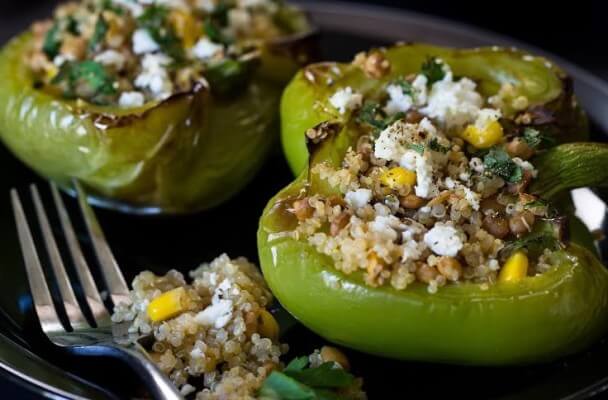
Quinoa Stuffed Peppers Recipe {gluten-free}
Another blend of quinoa and bell peppers, these compact meals also include crumbled cheese to add another dimension to the dish. Corn, lentils and spinach also add both nutritional value and texture to the plate- resulting in a mouthwatering dish that offers 37% of the DV for potassium, 27 grams of fiber, 30 grams of protein, 52% of the DV for iron, and more than 100% of the DV for vitamin C!
Ingredients: Quinoa, green bell peppers, canned lentils, fresh spinach, feta cheese, frozen corn (thawed), salt, black pepper.
Total Time: 40 minutes
| Yield: 6 servings (8 half-peppers)

Chocolate Goji Berry Bars Recipe {gluten-free}
A burst of sweet sensation that will drive you wild, this blend of the naturally sweet saccharinity of berries, the soft crunch of quinoa puffs, and a rich, deep sensation of a bittersweet dark chocolate topping offers a hearty helping of antioxidants and a sudden burst of energy to help you get through the day smiling!
Ingredients: Pitted dates, almond butter, quinoa puffs, goji berries, raw pistachios, coconut oil, dark chocolate chips.
Total Time: 20 minutes
| Yield: 8 bars

Blueberry Chia Jam Bars Recipe {gluten-free, vegan}
A delectable dessert or anytime snack, these sweet treats combine the antioxidant-rich blueberries with the superfood chia seeds to make an impressive offering of nutrition for such an opulent confection, including 4 grams of fiber and 3 grams of protein per serving.
Ingredients: Raw almonds, gluten-free rolled oats, chia seeds, maple syrup, water, vanilla or almond extract, blueberries, cacao powder, coconut oil.
Total Time: 30 minutes
| Yield: 16 mini bars
Recommended Vegetarian Snacks
These snacks supply a superb source of nutrients without any added meat and offer protein or other nutrients that are essential to a healthy vegetarian diet.
Healthy Eating
- Healthy Snacks
- Healthy Highlights
- 5 Uses for Cacao Powder
- 5 Ways to Eat Farro
- 6 Best Gluten-Free Foods
- Alcohol and the Body
- Almond Flour Recipes
- Anti-Aging Superfoods
- Beat the Afternoon Slump
- Benefits of a Plant-Based Diet
- Benefits of Baobab
- Benefits of Cashews
- Benefits of Coconut Oil for Hair
- Benefits of Coconuts
- Benefits of Dates
- Benefits of Fenugreek
- Benefits of Garcinia Cambogia
- Benefits of Goji Berries
- Benefits of Kale Chips
- Benefits of Monk Fruit Sweetener
- Benefits of Peanuts
- Benefits of Pecans
- Benefits of Pistachios
- Benefits of Pumpkin Seeds
- Benefits of Spelt Flour
- Benefits of Steel Cut Oats
- Benefits of Sunflower Seeds
- Benefits of Tiger Nuts
- Benefits of Turmeric
- Benefits of Walnuts
- Benefits of Wheatgrass
- Best Food Fads
- Cacao vs Cocoa
- Caffeine-Free Energy Foods
- Chocolate That's Good for You
- Diet vs. Exercise
- Fat Burning Foods
- Food Myths Debunked
- Foods for Bone Density
- Foods for Colon Health
- Foods for Healthy Hair
- Foods for Healthy Skin
- Foods to Help Sleep
- Foods to Reduce Stress
- Green Tea Benefits
- Healthy Baking Flours
- Heart Healthy Habits
- High Protein Health Risks
- How to Boost Your Metabolism
- How to Lose Weight While Aging
- How to Throw a Vegan BBQ
- Kaniwa vs Quinoa
- Little Health Foods
- Low-Carb: Fad or Friend?
- Making Healthier Desserts
- Mediterranean Diet Meal Plan
- Natural Beauty Products
- Nuts for Weight Loss
- Preparing Vegan Meals
- Preventing Muscle Degeneration
- Rare Superfoods
- Reduce Sugar Intake
- Save Time By Going Vegan
- Smarter Snack Swaps
- Smoothie Ingredients
- Soy Protein vs Whey Protein
- Starting a Plant-Based Diet
- Steel Cut vs Rolled Oats
- Sugar Substitutes
- Vegan Proteins
- Vegan Substitutions for Fall Recipes
- Why Go Vegan
- Healthy Meals
- Healthy Recipes
- Sports Nutrition
- Vitamins, Minerals & Nutrients

